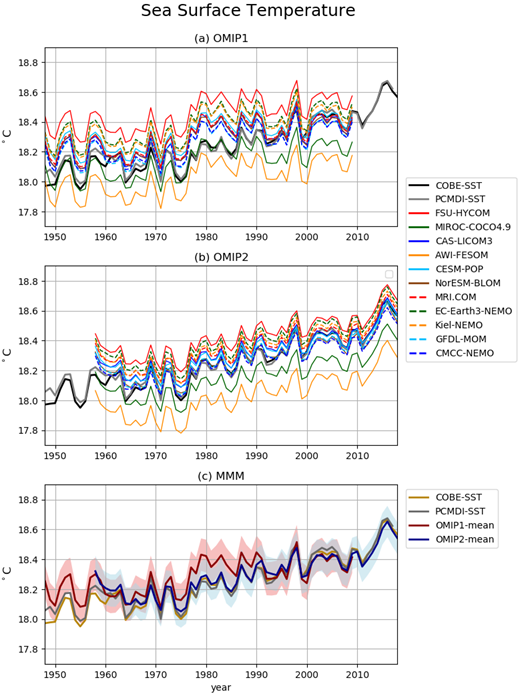An experimental protocol for global ocean-sea-ice model simulations and its evaluation: The Ocean Model Intercomparison Project phase 2 (OMIP-2)

Figure Multi-model mean 30-year (1980–2009) mean sea ice concentration (%). Columns are (from the left) OMIP-1, OMIP-2, OMIP-2 − OMIP-1, and an observational dataset provided by PCMDI. Rows are (from the top) March and September in the Northern hemisphere, and September and March in the Southern hemisphere. Blue lines are contours of 15% concentration of the PCMDI dataset and red lines are those of multi-model mean. (Taken from Figure 9 of Tsujino et al. 2020.)
A new framework for global ocean-sea-ice model simulations based on phase 2 of the Ocean Model Intercomparison Project (OMIP-2), was presented recently by CLIVAR Ocean Model Development Panel (OMDP) and other ocean model communities.
This OMIP-2 framework is assessed by comparing multi-model means from 11 CMIP6-class global ocean–sea-ice models calculated separately for the OMIP-1 and OMIP-2 simulations, based on the JRA55-do atmospheric dataset. Many features are very similar between these two simulations, and yet key improvements in transitioning from OMIP-1 to OMIP-2 are also identified. For example, in OMIP-2, the long-term simulations of the sea surface temperature (SST) are improved (Figure 1), the bias in the sea-ice concentration in summer of both hemispheres in OMIP-1 is significantly reduced, and also the overall reproducibility of both seasonal and interannual variations in SST and sea surface height is improved. The present assessment justifies that future ocean–sea-ice model development and analysis studies should use the OMIP-2 framework instead of OMIP-1.
The evaluation indicates that there are still remaining common model biases. Such as the errors from missing important processes in ocean-sea-ice models, the model resolutions, or the shared biases in the atmospheric forcing. Further efforts are needed to reduce the remaining biases in OMIP-2 such as those related to the erroneous representation of deep and bottom water formations and circulations. The authors suggest that such problems can be resolved through collaboration between those developing models (including parameterizations) and forcing datasets.
This work is published in the paper ‘Evaluation of global ocean–sea-ice model simulations based on the experimental protocols of the Ocean Model Intercomparison Project phase 2 (OMIP-2)”, which has been accepted for the journal Geoscientific Model Development.
******************
Evaluation of global ocean–sea-ice model simulations based on the experimental protocols of the Ocean Model Intercomparison Project phase 2 (OMIP-2)
Tsujino, H., Urakawa, L. S., Griffies, S. M., Danabasoglu, G., Adcroft, A. J., Amaral, A. E., Arsouze, T., Bentsen, M., Bernardello, R., Böning, C. W., Bozec, A., Chassignet, E. P., Danilov, S., Dussin, R., Exarchou, E., Fogli, P. G., Fox-Kemper, B., Guo, C., Ilicak, M., Iovino, D., Kim, W. M., Koldunov, N., Lapin, V., Li, Y., Lin, P., Lindsay, K., Liu, H., Long, M. C., Komuro, Y., Marsland, S. J., Masina, S., Nummelin, A., Rieck, J. K., Ruprich-Robert, Y., Scheinert, M., Sicardi, V., Sidorenko, D., Suzuki, T., Tatebe, H., Wang, Q., Yeager, S. G., and Yu, Z.: Evaluation of global ocean–sea-ice model simulations based on the experimental protocols of the Ocean Model Intercomparison Project phase 2 (OMIP-2), Geosci. Model Dev. Discuss., https://doi.org/10.5194/gmd-2019-363, in review, 2020.













